The OnLogic Helix HX500 Review: A Rugged Fanless 35W mini-PC
by Ganesh T S on September 17, 2021 10:00 AM EST- Posted in
- Systems
- Intel
- Fanless
- Industrial PC
- Passive Cooling
- Comet Lake
- OnLogic
Power Consumption and Thermal Performance
The power consumption at the wall was measured with a 4K display being driven through the DisplayPort port. In the graphs below, we compare the idle and load power of the OnLogic Helix HX500 with other low power PCs evaluated before. For load power consumption, we ran the AIDA64 System Stability Test, as well as our custom stress test with Prime95 / Furmark, and noted the maximum sustained power consumption at the wall.
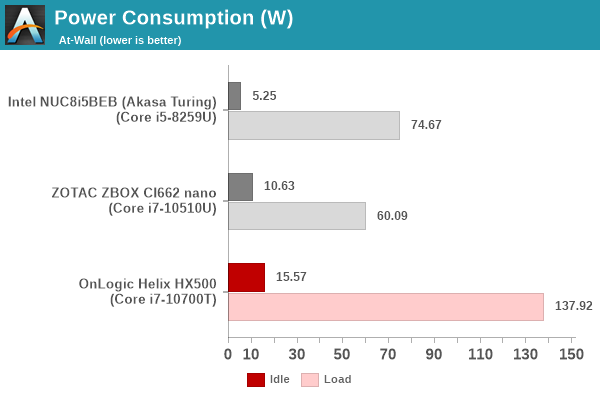
The PL1 / PL2 numbers are configured such that the instantaneous power consumption at the wall hit as much as 138W before settling down to a more comfortable (for the 120W power adapter) 60W.
Our thermal stress routine starts with the system at idle, followed by four stages of different system loading profiles using the AIDA64 System Stability Test (each of 30 minutes duration). In the first stage, we stress the CPU, caches and RAM. In the second stage, we add the GPU to the above list. In the third stage, we stress the GPU standalone. In the final stage, we stress all the system components (including the disks). Beyond this, we leave the unit idle in order to determine how quickly the various temperatures in the system can come back to normal idling range. The various clocks, temperatures and power consumption numbers for the system during the above routine are presented in the graphs below.
| OnLogic Helix HX500 System Loading with the AIDA64 System Stability Test | |||
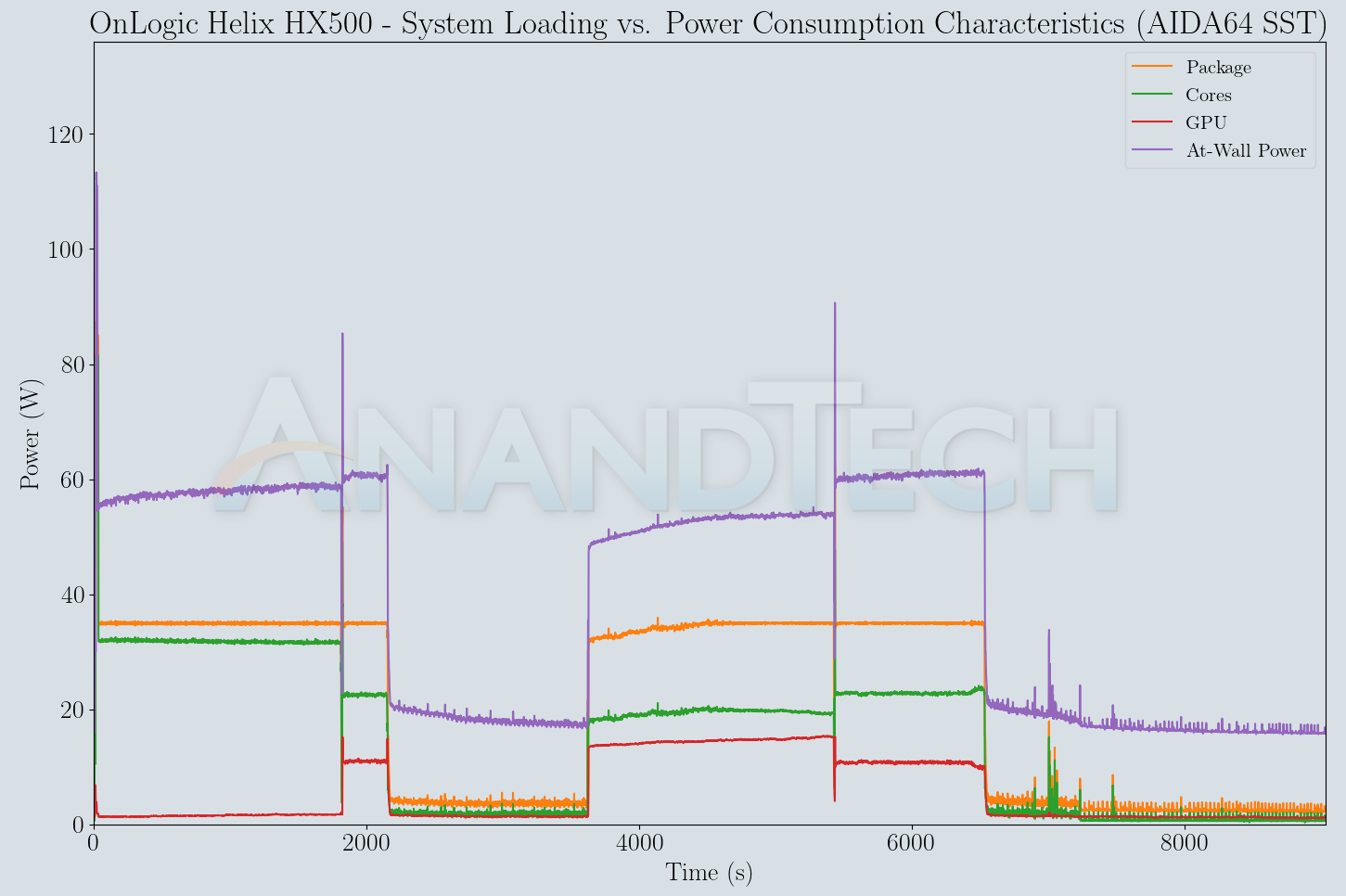
One of the unfortunate aspects during our AIDA64 SST was that the second and fourth workloads terminated in the middle without proceeding to completion. That can be observed from the power numbers above. Despite AIDA64 reporting a fatal error, the OS managed to keep running fine, as did our monitoring (evident from the full graph above, and the fact that AIDA restarted the next stress components set without issues).
Upon reaching out to OnLogic, their engineers repeated our tests, but did not manage to reproduce our findings.
After some analysis, OnLogic's engineers came to the conclusion that AIDA64 was interpreting a throttling flag as a failure. The HX500 was designed to throttle slowly starting at 95°C instead of the standard 100°C to improve reliability and the end customer experience. This allows the throttling to slowly ramp down the clocks as the high temperatures are hit when the systems are deployed in higher temperature environments. This avoids the sawtooth clocks / performance, which can negatively impact end user applications. Apparently, AIDA64 sees this as a hard failure and quits the test instead of continuing to run with the flags set by the implemented throttling mechanism.
Backing up OnLogic's claims, our custom stress test with Prime95 and Furmark had no problems in completing the workloads, while maintaining a steady 35W package power consumption, and around 60W at the wall.
| OnLogic Helix HX500 System Loading with Prime95 and Furmark | |||
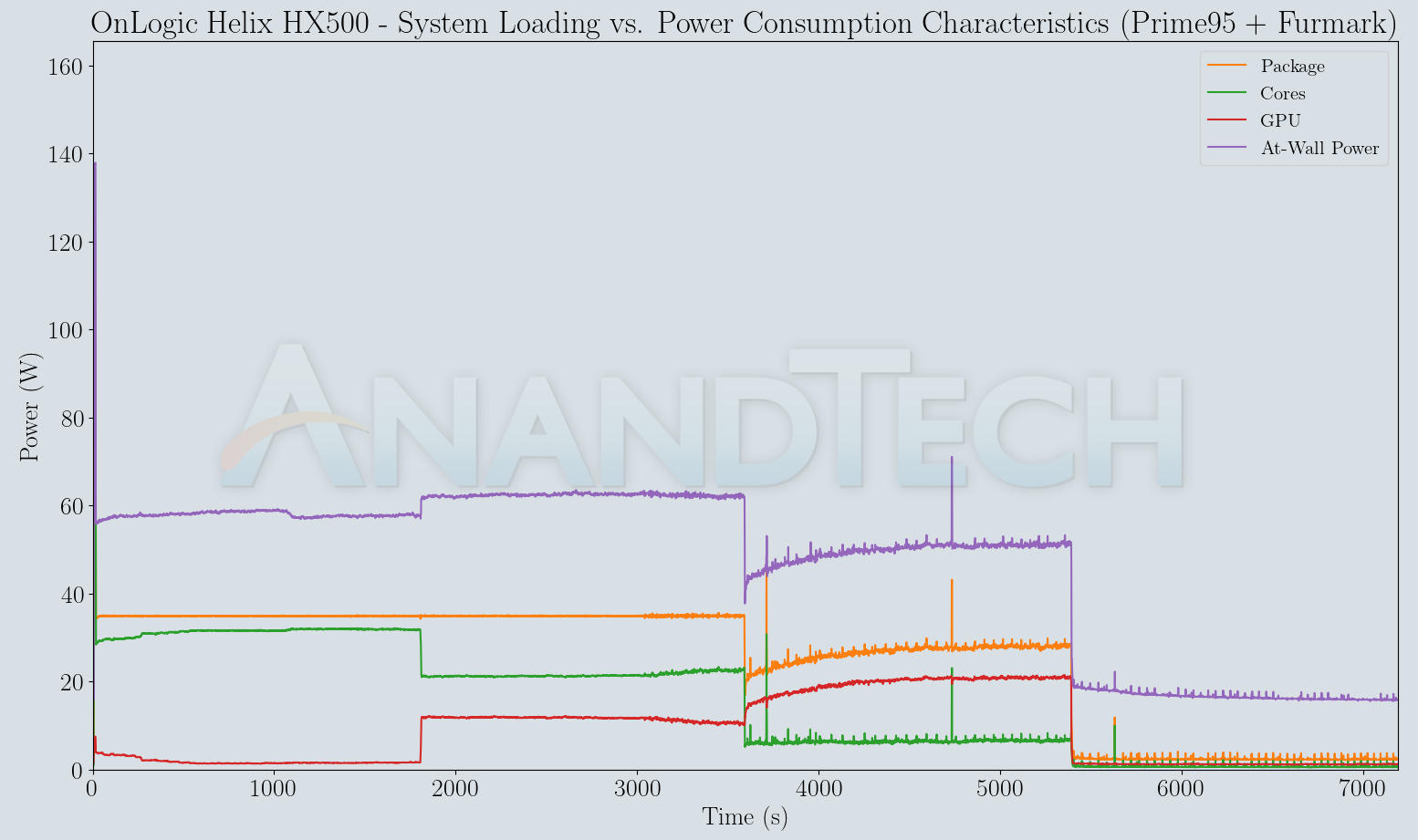
In terms of temperatures, we do end up around 98C in both our stress tests, and this matches OnLogic's own testing scenarios in their Helix manual. The key here is that the solution is able to handle 35W TDP for an extended duration (our testing is limited to around 3 hours, while the tests described in the Helix manual (PDF) run for a much longer duration).


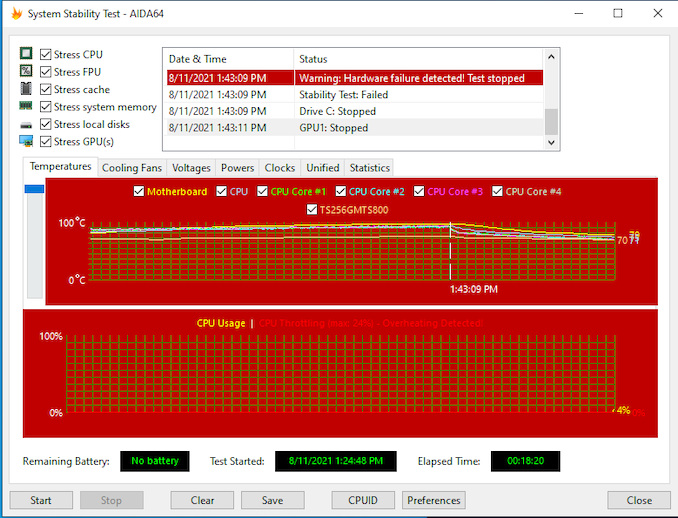
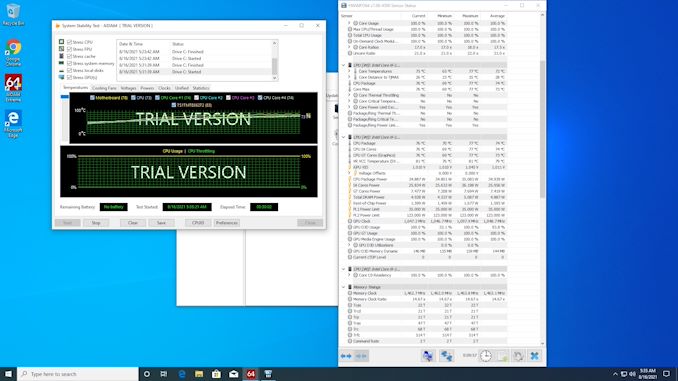








32 Comments
View All Comments
Oxford Guy - Friday, September 17, 2021 - link
130W with a 120W adapter.Thermal throttling.
Double failure.
Oxford Guy - Friday, September 17, 2021 - link
138W.Wrs - Saturday, September 18, 2021 - link
No issue there. Adapter is rated for DC output; review measured AC input “at the wall.” 120 into 138w is 87% efficient. We don’t actually know the system was pulling the full 120w DC. The fanless system obviously cannot dissipate that sustained, but settles in the 50-55w range, 60w at the wall. That’s how modern CPUs work. They idle cold, blow past the normal power budget for load and then settle closer to rated power when things warm up.Oxford Guy - Saturday, September 18, 2021 - link
Ok. Thanks for the clarification.So, it's only a single design failure then (thermal throttling).
My view of thermal throttling is that it should only happen as a preventative measure to keep a system from being ruined due to user error (such as letting a machine become clogged with dust).
Otherwise, you're clocking the chip wrong or doing something else wrong with the design. Stuffing 14nm into a passive case in 2021 probably is part of the mistake.
But, for tricking people with numbers I guess hiding the real performance behind a shifting facade of throttling is fun.
Wrs - Sunday, September 19, 2021 - link
So there is normal throttling and then there is emergency throttling or sometimes shutdown. The CPU is rated for 35w, even though the same silicon is known to be capable of 65 or 95w. What they do is as long as all the temperatures are cool, they let the silicon use 60w+ for a few seconds. This can happen in a laptop, or in this industrial enclosure. It makes it feel just as fast as a desktop, but it can’t last for a heavy sustained workload because of heat buildup. After it warms up, it goes back down to the voltage and frequency it was designed to sustain.It has nothing to do with 14nm. My 7nm desktop works similarly. In 2021 Intel’s got 10nm for low-power (that’s what all Tiger Lake laptops are), but OnLogic was too cheap for that or figured their clientele doesn’t want the latest and greatest. Their case successfully prevented the 35w chip from emergency throttling, so it passed the thermal design test in my book.
Oxford Guy - Sunday, September 19, 2021 - link
Marketing magic to try to justify inadequate cooling. Not a fan.Wrs - Monday, September 20, 2021 - link
I mean, it is a fanless, almost sealed enclosure the size of a standing router or cable modem - how much more can you expect? The benchmarks were more than fine. They way outclassed the Zotac, which is also fanless and the size of a router, but uses commodity plastic hole vents which would be wholly inappropriate in industrial settings but would be suitable as a living room htpc. The OnLogic system gets close to 80c peak on the case; one would hope for the sake of longevity that they used high temperature components throughout and that would be the reason for the high price.Potential improvements are obviously a finer process node like Tiger Lake or one of the Zen 3 laptop chips, a low-power specialized fab node... but all that R&D takes time and $$. The world isn't perfect and we don't have infinite population.
Oxford Guy - Tuesday, September 21, 2021 - link
‘how much more can you expect’I expect parts to match the capability of the cooling versus putting too-demanding parts into a box and relying on throttling. If the parts need a larger heatsink box then use that or choose less demanding parts.
The only exception is turbo that is designed to safely ‘overclock’ a chip if the cooling is better than the norm. That is a good feature.
Wrs - Tuesday, September 21, 2021 - link
As far as I can tell the parts match very well. All the CPU choices for the little box top out at 35w. Obviously the 138w momentary draw came from turbo; there is no separate GPU. The review found the junction temperature under sustained load hit 98C which is just under the throttling temp of 100C. A 15w chip would have undersold the capabilities of the design, and a 65w+ desktop part would have been throttled under sustained load unless perhaps operating out of Antarctica…That’s not to say some won’t take issue with the incomplete seal, or that there might be component longevity issues down the road which is where a warranty comes in.
Jonny314159 - Friday, September 17, 2021 - link
Any VRM cooling on this? I think I see a thermal pad for the SSD, but the VRMs will be a long term point of failure running in a sealed box with no conductive path to the heatsink.